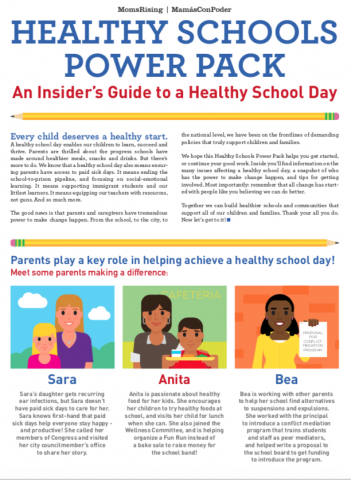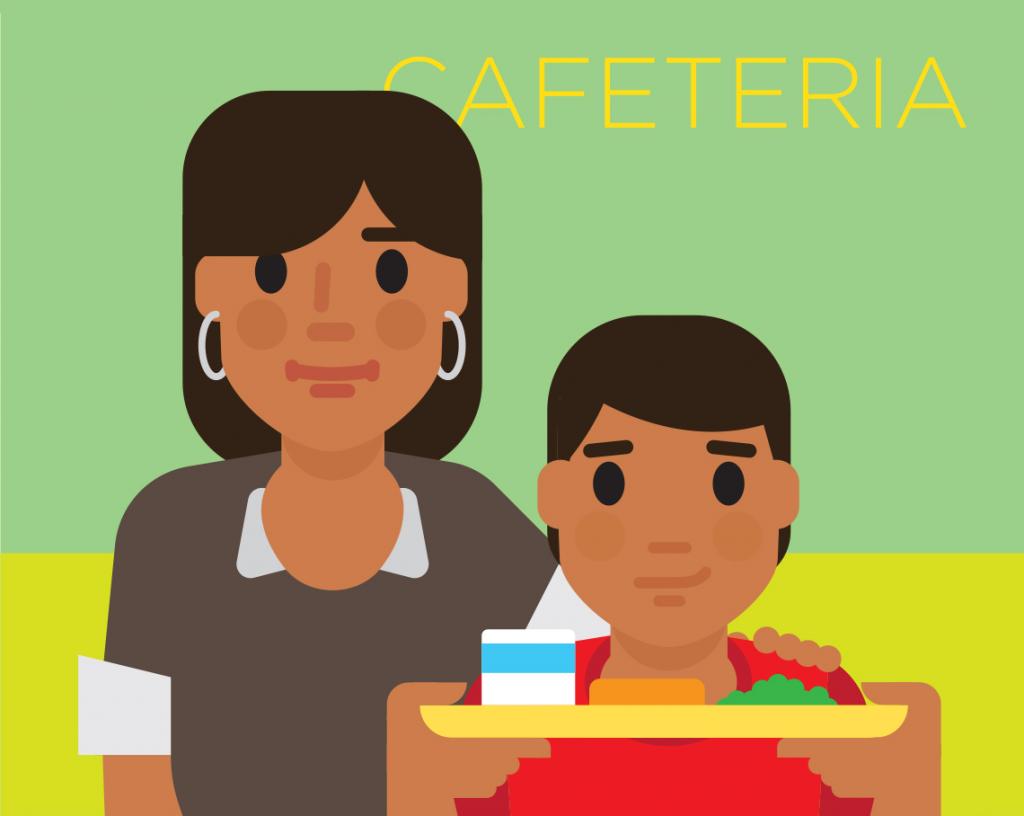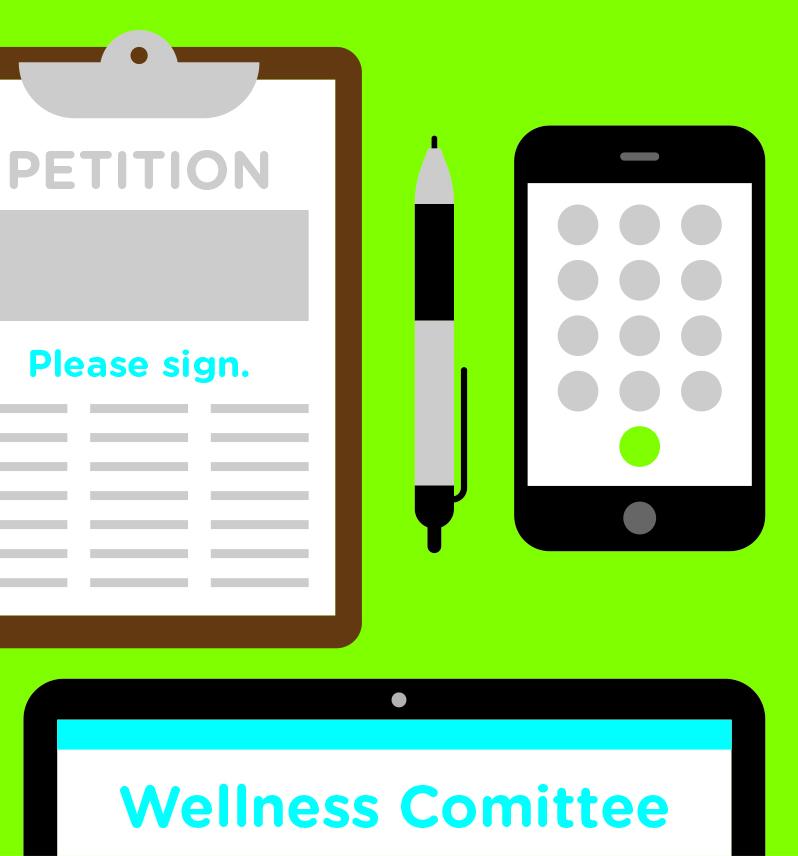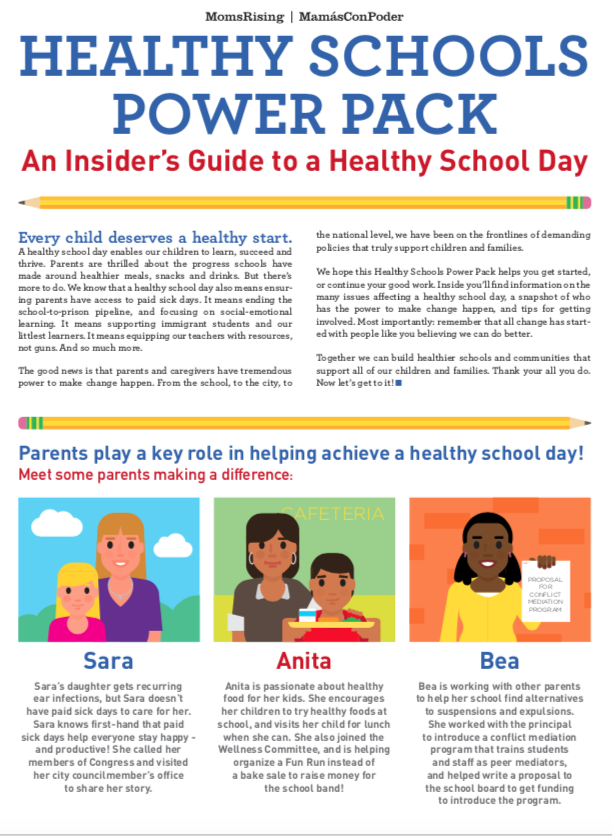
Every child deserves a healthy start. A healthy school day enables our children to learn, succeed and thrive. Parents are thrilled about the progress schools have made around healthier meals, snacks and drinks in recent years. But there's more to do. We know that a healthy school day also means ensuring parents have access to paid sick days. It means ending the school-to-prison pipeline, and focusing on social-emotional learning. It means supporting immigrant students and our littlest learners. It means equipping our teachers with resources, not guns. And so much more.
The good news is that parents and caregivers have tremendous power to make change happen. From the school, to the city, to the national level, we have been on the frontlines of demanding policies that truly support children and families.
We hope this Healthy Schools Power Pack helps you get started, or continue your good work. Inside you'll find information on the many issues affecting a healthy school day, a snapshot of who has the power to make change happen, and tips for getting involved. Most importantly: remember that all change has started with people believing we can do better. Together we can build healthier schools and communities that support all of our children and families.
Find highlights below, and the full download here.
Bea is working with other parents to help her school find alternatives to suspensions and expulsions. She worked with the principal to introduce a conflict mediation program that trains students and staff as peer mediators, and helped write a proposal to the School Board to get funding to introduce the program. | |
Sara's daughter Maria gets recurring ear infections. Sara shouldn't have to choose between a paycheck and taking care of Maria when she’s sick. Sara knows first-hand that paid sick days help everyone stay happy - and productive! She called her Members of Congress and visited her City Councilmember's office to share her story. | |
Anita is passionate about healthy food for her kids. She encourages her children to try healthy foods at school, and visits her child for lunch when she can. She also joined the Wellness Committee, and is helping organize a Fun Run instead of a bake sale to raise money for the school band! |
Current guidelines recommend that kids get 60 minutes of movement a day, but 22% of schools don’t require physical education. In fact only 4% of elementary, 8% of middle and 2% of high school students provide daily PE. When kids move and exercise their bodies they are better able to focus in class, and they perform better in school. Studies show that academic achievement increases when students are physically active. | |
All too often sick children are sent to school because a parent doesn't have access to paid sick days. Contagious illnesses like the flu spread more quickly in schools than in the workplace. Studies also show that sick children recover better when cared for by their parents. Parents shouldn't have to give up a paycheck, or risk losing your job, to care for family. | |
The school-to-prison pipeline pushes students out of school with exclusionary disciplinary policies that include suspensions, expelling or even arresting kids for minor offenses that use to be mediated by principals and school staff. Students of color and students with disabilities are disproportionately affected. More than 1:4 boys of color with disabilities and nearly 1:5 girls of color with disabilities receives an out of school suspension. | |
Early learning programs support social-emotional development, cognitive development, and go a long way in setting up our little ones for success. Studies show that children who have high-quality early learning experiences are more likely to succeed in school, graduate from high school, and gain stable employment. For every $1 invested in high-quality early learning there is an economic return of 13%. | |
Multilingual educational programing, like dual language immersion programs, are one of the most effective strategies for closing the opportunity gap for all students before it starts while also ensuring our kids have competitive advantage when they enter the global workforce. Students who know more than one language have exhibited increased emotional intelligence, stronger problem solving skills, and improved academic outcomes. | |
Schools can help support immigrant families by: providing information in their language, offering resources like know-your-rights workshops, and working with community organizations to fill the specific needs of the community. Schools can also provide counseling and referral services for students who may be affected by current immigration policy, including support for children whose parents might be detained | |
Gun safety is a top priority for parents and students, with another wave of heartbreaking tragedies in 2018. Students are leading an inspiring charge demanding sensible gun laws in our communities. As parents we must back them up. We must also ensure that schools invest in resources that are actually proven to improve learning and school safety, including counselors, and address the emotional and psychological needs of our students. | |
Healthy school food, snacks and drinks are an important part of the healthy school day. Not only do schools teach healthy habits that last a lifetime, but when children eat healthy food, they're ready to learn, focus and succeed in school, too. Children eat half of their daily calories in school, and these calories are even more important if a child experiences food insecurity at home. |
Share your story. Your story is one of your most powerful tools. Always share why you’re passionate about an issue. It helps build connections, relationships, trust and goodwill. Articulating your experience is a great way to begin a meeting, statement or email. | |
Build your squad. When you are really passionate about something, it can be tempting to forge ahead without taking the time to build relationships and get feedback from others. But change can take time, and many hands. You need a team of people excited about the issue and eager to help. Spend time speaking with teachers, parents and allies who will support your cause. | |
Identify who has the power to make change happen. Always explore who has stake in an issue you care about, and think about what will influence them. Do they need more information, or parent support? Will they respond to letters from students? Are they elected, and likely to respond to parents who vote, or an article in the paper? The answers will help you identify what actions to take. | |
Take Action. Remember: People like us have made great things happen. Use your voice to get involved. Talk with other parents. Ask your principal how you can help. Attend school board meetings, or sign up for the Wellness Commmittee. Call your representatives. It ALL makes a difference! |
Click this link or image below to download your copy!













The views and opinions expressed in this post are those of the author(s) and do not necessarily reflect those of MomsRising.org.
MomsRising.org strongly encourages our readers to post comments in response to blog posts. We value diversity of opinions and perspectives. Our goals for this space are to be educational, thought-provoking, and respectful. So we actively moderate comments and we reserve the right to edit or remove comments that undermine these goals. Thanks!